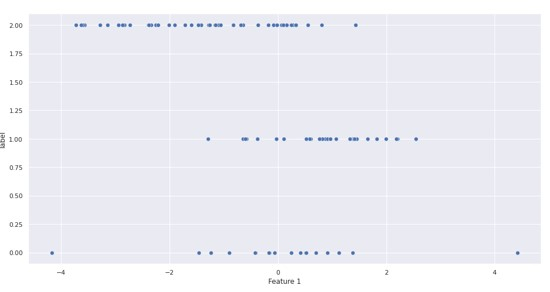
 Data Structure
Data Structure Networking
Networking RDBMS
RDBMS Operating System
Operating System Java
Java MS Excel
MS Excel iOS
iOS HTML
HTML CSS
CSS Android
Android Python
Python C Programming
C Programming C++
C++ C#
C# MongoDB
MongoDB MySQL
MySQL Javascript
Javascript PHP
PHP
- Selected Reading
- UPSC IAS Exams Notes
- Developer's Best Practices
- Questions and Answers
- Effective Resume Writing
- HR Interview Questions
- Computer Glossary
- Who is Who
How to Create simulated data for classification in Python
In this Tutorial we will learn how to create simulated data from classification in Python.
Introduction
Simulated data can be defined as any data not representing the real phenomenon but which is generated synthetically using parameters and constraints.
When and why do we need simulated data?
Sometimes while prototyping a particular algorithm in Machine Learning or Deep Learning we generally face a scarcity of good real-world data which can be useful to us. Sometimes there is no such data available for a given task. In such scenarios, we may need synthetically generated data. This data can also be from Lab Simulations.
Advantages of simulated data
Mostly represents data as it might be in the real form
Contains less variation of noise, so can be considered an ideal dataset
Useful for quick prototyping and POCs
Generation of simulated data for classification using Python
In this demonstration, we are going to use sci-ki learn to generate simulated data.
Example
from sklearn.datasets import make_classification import pandas as pd import seaborn as sns # Creating a simulated feature matrix and output vector with 100 samples features, output = make_classification(n_samples = 100, # taking ten features n_features = 10, # five features that predict the output's classes n_informative = 5, # five features that are random and unrelated to the output's classes n_redundant = 5, # three output classes n_classes = 3, # with 20% of observations in the first class, 30% in the second class, # and 50% in the third class. ('None' makes balanced classes) weights = [.2, .3, .8]) print("Feature Dataframe: "); df_features = pd.DataFrame(features, columns=["Feature 1", "Feature 2","Feature 3", "Feature 4", "Feature 5","Feature 6", "Feature 7", "Feature 8", "Feature 9", "Feature 10"]) output_series = pd.Series(output,name='label') df = pd.concat([df_features,output_series],axis=1) print(df.head()) ## plot using seaborn sns.set(rc={"figure.figsize":(16, 8)}) ## Plotting 'Feature 1' vs label sns.scatterplot(data=df,x='Feature 1',y='label',s=50)
Output
Feature Dataframe: Feature 1 Feature 2 Feature 3 Feature 4 Feature 5 Feature 6 \ 0 0.849715 -0.381343 0.650106 -1.439747 -0.442026 0.785891 1 1.841786 0.912779 2.090686 -2.220130 -0.744132 -0.116817 2 -0.915034 -3.324696 -2.613417 0.852612 -3.908363 4.352266 3 1.305116 -1.582905 -0.797318 -0.943912 -1.753893 1.721998 4 0.894486 -0.130399 -0.968311 0.989773 -0.987330 -0.296457 Feature 7 Feature 8 Feature 9 Feature 10 label 0 0.119725 1.156633 0.794226 0.511587 2 1 -0.064624 2.311732 0.178347 1.294978 1 2 3.038898 -2.273558 4.194868 2.693096 2 3 0.817046 0.577196 2.651006 1.826657 2 4 -0.280331 0.096983 1.227921 0.909471 2

Another method is using the Faker python library. Let's see through the below example. Installing the Faker library
Example
!pip install Faker from random import randint import pandas as pd from faker import Faker from faker.providers import DynamicProvider medical_professions_provider = DynamicProvider( provider_name="medical_profession", elements=["dr.", "doctor", "nurse", "surgeon", "clerk"], ) fake = Faker() fake.add_provider(medical_professions_provider) def input_data(x): # pandas dataframe data = pd.DataFrame() for i in range(0, x): data.loc[i,'id']= randint(1, 100) data.loc[i,'name']= fake.name() data.loc[i,'address']= fake.address() data.loc[i,'latitude']= str(fake.latitude()) data.loc[i,'longitude']= str(fake.longitude()) data.loc[i,'target'] = str(fake.medical_profession()) return data print(input_data(10))
Output
id name address \ 7.0 Monique Rodriguez 481 Rebecca Landing Suite 727\nDominiquefurt, ... 4.0 Elizabeth Johnson 62492 Zimmerman Crest Apt. 047\nPort Jerome, W... 18.0 Max Rangel 4379 Obrien Curve\nDavistown, IA 02341 31.0 Tammie Kent 4866 Angela Turnpike Apt. 658\nNorth Sheilabor... 42.0 James Johnston 26827 Jeremiah Alley\nFreystad, SC 86902 21.0 Shawn Robles 137 Jessica Ridges Apt. 436\nWilliamburgh, AZ ... 13.0 Stephen Hodges Unit 9799 Box 0625\nDPO AA 94415 91.0 Eric Lewis PhD 4711 Nicholas Loaf\nWest Lisa, UT 28944 68.0 Matthew Munoz 37836 White Crest\nGonzalezport, NC 75320 34.0 Lawrence Anderson 76712 Garza Mills Apt. 751\nPort Penny, CT 43042 latitude longitude target 0 60.574796 109.367770 clerk 1 84.7225155 -167.216393 dr. 2 82.598649 62.961322 surgeon 3 26.9617205 89.333171 doctor 4 -37.1740195 -140.766121 dr. 5 -40.8904645 28.820918 clerk 6 88.809220 76.442779 dr. 7 35.728143 178.729120 doctor 8 -16.5669945 126.686740 dr. 9 -49.271970 160.737754 clerk
Conclusion
Simulated data is highly useful in day-to-day Machine Learning applications for prototyping or small POCs. There are some handy tools in Python which make this highly simple to create simulated data within a few lines of code.

